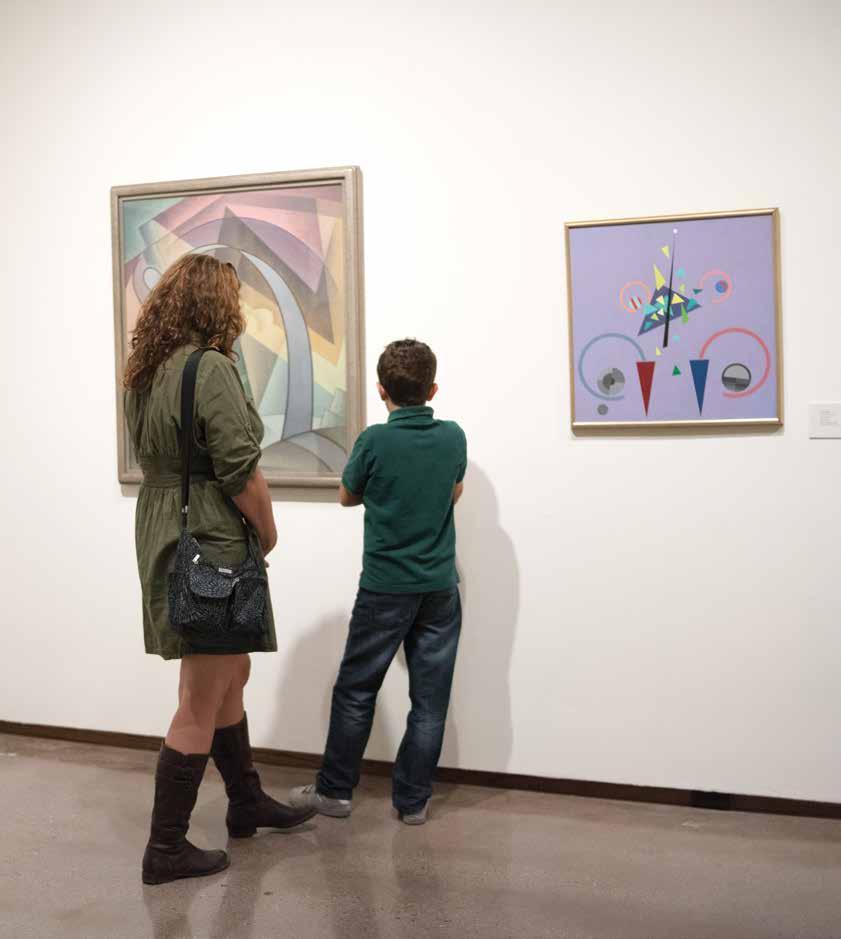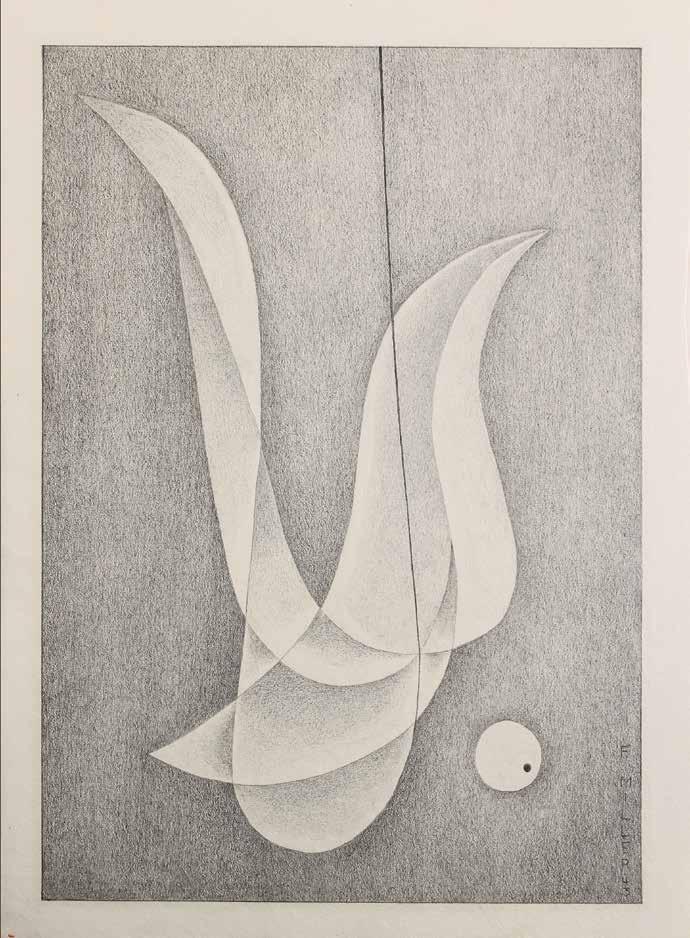
7 minute read
VLADEM CONTEMPORARY
Museum of What’s Happening Now
Vladem Contemporary Looks Ahead
In 1917, Museum of New Mexico founder Edgar Lee Hewett launched a cutting-edge artistic experiment in Santa Fe. With Ashcan School painter Robert Henri, Hewett dreamed up a museum with a progressive open-door policy that would allow local artists to exhibit their work.
As Hewett and Henri envisioned it, the striking new museum would not only showcase the finest artists the region had to offer, it would also help to define New Mexico’s place among the greater art world. Designed to have a lasting footprint on the historic Santa Fe Plaza, the institution was constructed in the Pueblo Revival style. Over the next hundred years, it would come to symbolize the city’s artistic and architectural identity.
With the future opening of the Vladem Contemporary in Santa Fe’s Railyard District, today’s New Mexico Museum of Art expands that century-old mission. The identity behind the Vladem’s facade—a mantra of “one museum, two locations”—is in the service of a unified vision between the old and the new.
The Vladem’s first year of programming is centered around a three-exhibition trifecta that uses both buildings—one from the 20th century Plaza, one from the 21st century Railyard—to tell the story of the museum’s unique collection.
“We’re continuing to do what we’ve always done,” says Merry Scully, the museum’s curator of contemporary art. ”We’re a living, breathing institution that is a part of the community. And the new location and the different kinds of spaces in it really allow that to happen.”
Envisioning the Inaugural Exhibition
The galleries at the Vladem will add 10,000 additional square feet to showcase the museum’s postwar and contemporary collection, which includes both regional, national and international artists. The Vladem is also designed to host electronic, new media and larger-scale works that were impossible to exhibit in the historic Plaza building.
In addition to the $12.5 million raised to build the Vladem through the Museum of New Mexico Foundation’s Centennial Campaign is a $2 million funding goal for the Vladem’s inaugural yearlong exhibitions and first three years of programming.
“As we pivot our fundraising efforts from capital to programming, we feel confident that the wonderful support our donors gave to the construction project will continue with an equally strong commitment to make year one at the Vladem truly extraordinary,” says Foundation President/CEO Jamie Clements.
The inaugural exhibition is envisioned to celebrate the architectural achievement of the new Vladem with works that are planned to be presented, in Scully’s words, “in, on, and around the building.” Those works might include an LED light installation, a public performance, screenings of single-channel video films and displays of large-scale works in the lobby space.
“I want to do things in the galleries, I want to do things on the grounds, I want to do things around the grounds so that it’s really alive,” Scully says of her programming goals. “We do have restrictions downtown. The new building takes away some restrictions with a really usable outdoor area, a classroom and an artist’s studio.”
Other possible sites of artistic engagement include the Railyard Plaza, near where Rail Runner passengers disembark, as well as the upper terrace of the museum and the area under the building’s overhang.
Scully is centering the Vladem’s first show around the universal theme of shadow and light. “How we see things is through their definition, through shadow and light,” she explains. “It also speaks about ideas of good and evil, those epic themes that are often part of the visual arts.”
Visitors will also consider the famous New Mexico light, which brought hordes of photographers and painters to the Land of Enchantment in the 20th century.
In a metaphorical sense, Scully also is interested in the idea of illuminating more obscure histories. “There’s a broader definition of art history that includes the West, that includes women, that includes people of color, and tying what we’ve been supportive of here for decades to what’s happening nationally and internationally,” she says.
At the Vladem, that story is rooted in the Transcendental Painting Group, the pre-World War II group of Southwest painters including Raymond Jonson, Emil Bisttram and Florence Miller Pierce, who embraced spiritual themes through abstraction. From there, the exhibition will
Previous page: Photo © Andrew Kastner. Opposite: Florence Miller Pierce, Untitled, 1943. Graphite on paper. Museum purchase with funds from the Boeckman Acquisition Fund, 1997 (1997.48.3). Photo by Cameron Gay.

move to artworks from the Light and Space, conceptual and land-based art movements in order to spotlight a more inclusive canon of diverse and wildly creative artists from the West and Southwest.
Scully says this reconfigured arc is in line with the museum’s original mission. “It’s not just a regional art history, it’s going to be an art history that includes our region. As people are redefining what ‘American art’ means, we’re redefining what’s included in postwar work.”
Indeed, alongside works from the Museum of Art’s collection, and loans from public and private collections, the museum is discussing new commissions for projects and performances. Confirmed loans for the inaugural exhibition include pieces by South Korean artist Lee Bul, the relatively unsung Light and Space member Helen Pashgian, and renowned sculptor and installation artist Yayoi Kusama. Other artists who might make their way into the show include Ron Cooper, Gloria Graham, Sol LeWitt, Virgil Ortiz, Mike Kelley and Nancy Holt. While the Vladem exhibition helps to define New Mexico’s place in the contemporary canon, two additional shows at the New Mexico Museum of Art’s Plaza location will emphasize the museum’s historic Southwest and Modernist collections.
A winter 2022 exhibition, tentatively called Western Eyes: Modern Art of the New Mexico Museum of Art and assembled by curator of 20th century art Christian Waguespack, will use the entirety of the historic building to juxtapose work by Southwestern artists with that of major Modernists from elsewhere.
Additionally a photography exhibition with the working title Exploding the Canon opens in the New Wing in spring 2022. In that show, curator Katherine Ware aims to display photographs that challenge viewers’ expectations of the genre and underscore the vitality of the museum’s photographic collection.
The Vladem represents a fork in the road for the Museum of Art, reaching toward a more nuanced and expanded definition of both Southwest and contemporary art. But Scully emphasizes that the museum’s exhibitions in the Vladem’s first year will highlight different aspects of the same story begun by Hewett and Henri in 1917.
“I feel it’s really important we open the Vladem shows before the other shows,” Scully says, “in order to tie the two institutions together.”

The future Vladem Contemporary. Image courtesy DNCA Architects and StudioGP.
Left: Merry Scully, New Mexico Museum of Art curator of contemporary art. Photo courtesy New Mexico Museum of Art. Right: Yayoi Kusama, Pumpkin, 2015. Stainless steel, urethane. Photo courtesy TIA Collection.


Funding the Future
In addition to funding the inaugural Vladem exhibition, the Foundation plans to raise an additional $75,000 to fund the inaugural year of public education programs.
“Our commitment to the Museum of Art is to raise the funds needed for both exhibitions and educational programs,” says Clements.
In the spirit of the Museum of Art’s longtime community engagement, the Vladem seeks to bring new artists into the fold in various ways. These include adding new works to the collection via artist commissions. Public programs, performances in the classroom space, galleries or outside areas, and an artist-in-residence program are other ideas for artist engagement.
Curators are also hoping to build partnerships and community engagement with the Vladem’s surrounding neighborhood, which includes the nearby New Mexico School for the Arts.
Scully expresses excitement about the new building’s off-the-Plaza location, noting that while many Santa Feans tend to avoid the downtown area during the summer tourist season, locals are much more likely to frequent the Railyard—thus having the potential to be drawn in by the Vladem’s highly visible approach to contemporary art.
“Often people think of us as a museum for just occasional special shows, or for tourists,” Scully says. “I think being in the Railyard firmly ties us to what’s happening in the arts in New Mexico now.”
Scully points to a quote from Edgar Lee Hewett, which despite its antiquated language, expresses the same central ideas. Of the institution he began in 1917, Hewett decorously wrote:
“This building that we have erected expresses something of our gratitude for, and appreciation of, these artists. It is an effort to worthily display their works, to bring them the attention of the world, to the end that multitudes may share our pleasure.”
As the Vladem Contemporary extends the art museum’s reach from the Plaza to the Railyard, from the old to the new, Hewett’s goals are as relevant as ever.
Plans for future exhibitions, though current as of April 30 press time, are subject to change.










